Physical Address
304 North Cardinal St.
Dorchester Center, MA 02124
Physical Address
304 North Cardinal St.
Dorchester Center, MA 02124
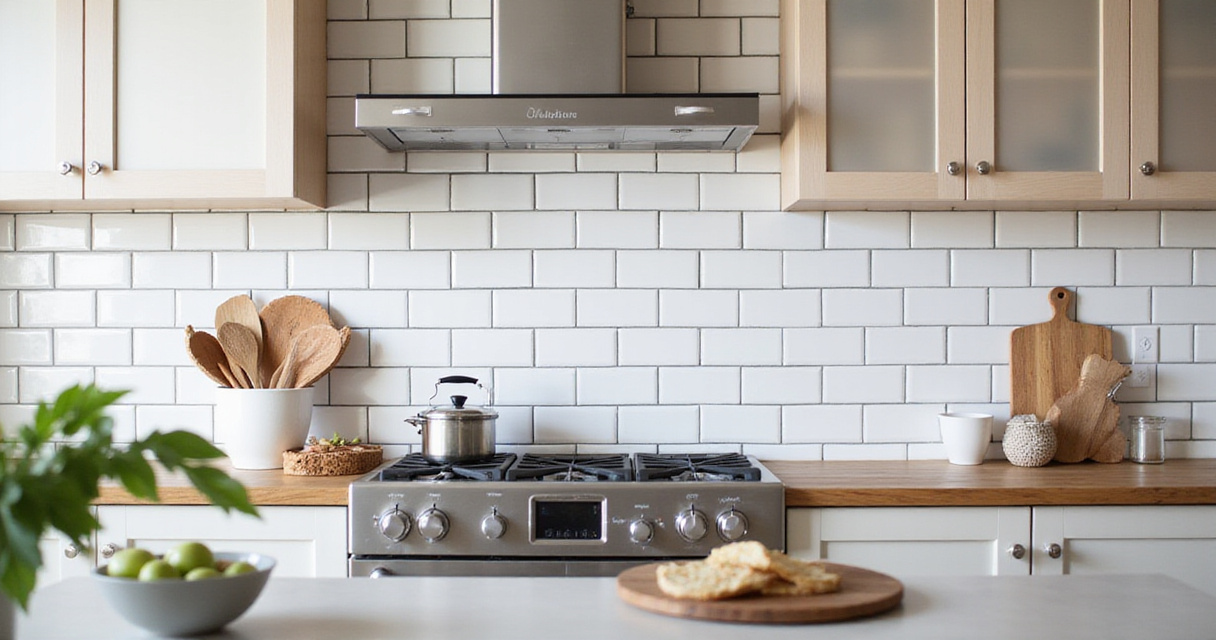
Discover 20 stunning kitchen tile ideas from subway patterns to bold colors. Transform your space with expert tips on materials, layouts, and installation techniques.
The kitchen stands as the heart of the home, where daily life unfolds through morning coffee rituals, family dinners, and late-night conversations. While appliances and cabinets often command attention during renovations, tile holds the unique power to completely transform your space’s character. From backsplashes that catch morning light to floors that anchor your design vision, the right tile choices create lasting impact that extends far beyond mere functionality.
Today’s tile options offer unprecedented variety in materials, patterns, and finishes, opening doors to design possibilities that reflect your family’s unique story. Whether you’re accommodating multiple generations with practical yet beautiful surfaces, or seeking to blend cultural influences through color and texture, thoughtful Tile Selection becomes an investment in both daily comfort and long-term home value. The key lies in understanding how different tile approaches can serve your specific needs while creating the atmosphere you envision.
Ready to discover how strategic tile choices can redefine your culinary space? These 20 kitchen tile ideas combine practical wisdom with design inspiration, helping you navigate options that work beautifully for real families in real homes.
White subway tile remains a beloved choice for its timeless appeal and versatility across design styles. However, standard white or light gray grout can sometimes leave this classic looking predictable. The magic happens when you choose bold contrasting grout colors like charcoal, navy, or even deep forest green. This simple shift transforms humble subway tile into a graphic statement that defines your kitchen’s personality.
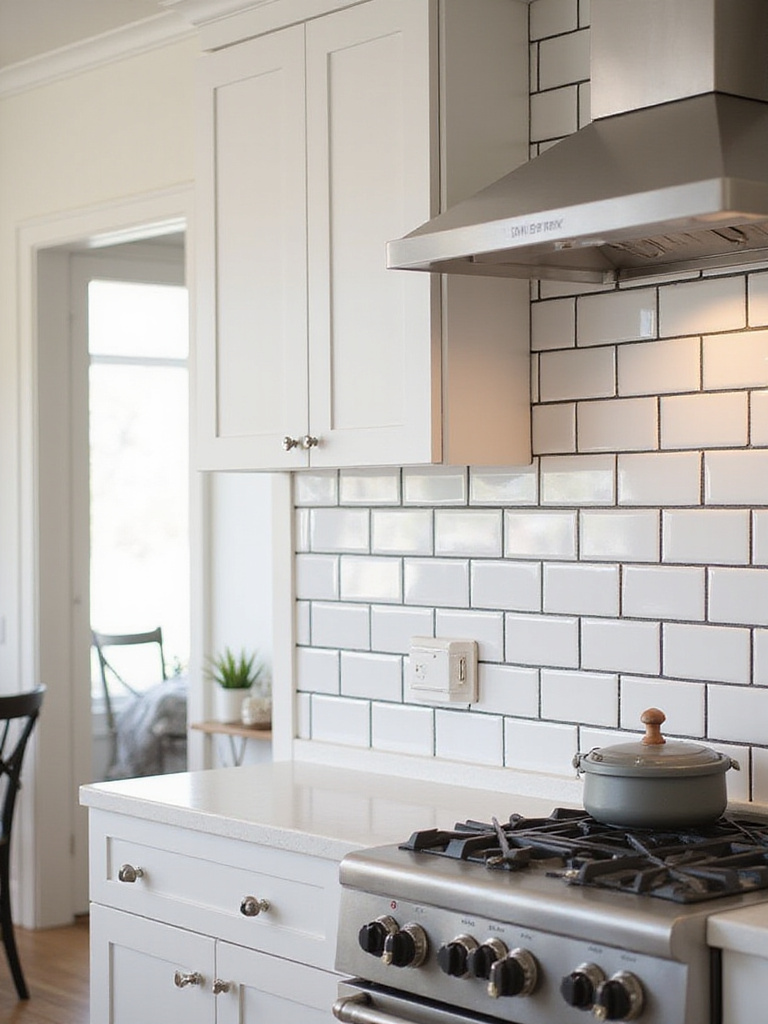
The practical benefits extend beyond aesthetics. Dark grout lines hide everyday kitchen mishaps – those inevitable splashes of tomato sauce or coffee drips that would stand out starkly against white grout. This means less frequent deep cleaning and a backsplash that maintains its crisp appearance with minimal effort. The high contrast also emphasizes the tile’s classic brick pattern, adding architectural interest that draws the eye upward and can make smaller kitchens feel more spacious.
Implementation requires careful attention to cleanup during installation. Mix your chosen grout color according to manufacturer specifications, apply firmly into joints, and immediately wipe excess from tile surfaces with a damp sponge. The key is working in small sections and rinsing your sponge frequently to prevent grout haze that can dull the tile’s finish.
The interplay between the colors creates a foundation that works beautifully with both traditional and contemporary elements, setting the stage for exploring dynamic patterns.
Moving beyond standard grid layouts, the herringbone pattern introduces sophisticated visual movement that transforms ordinary rectangular tiles into architectural art. This classic V-shaped arrangement works with any size tile, from traditional subway dimensions to larger planks, creating diagonal lines that guide the eye and add energy to your kitchen walls or floors.
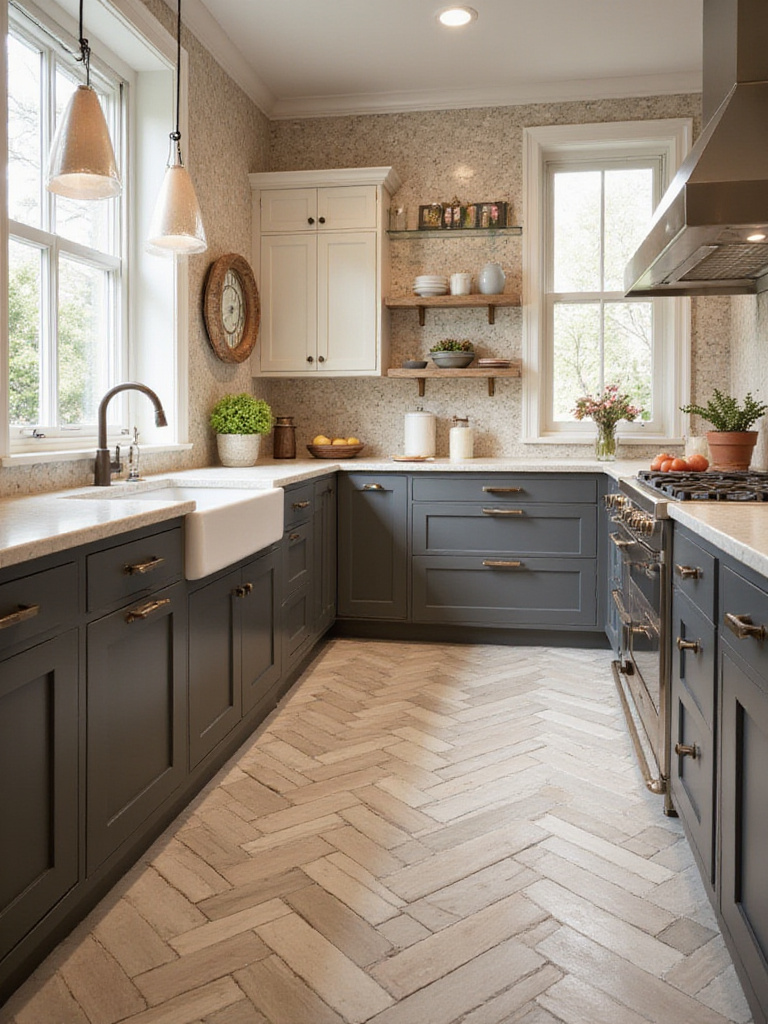
The pattern’s genius lies in its ability to alter spatial perception. In galley kitchens, herringbone can make narrow spaces feel wider, while vertical applications draw attention upward, emphasizing ceiling height. The complexity of the pattern also disguises minor imperfections in wall surfaces better than straight layouts, making it forgiving for older homes where walls might not be perfectly plumb.
Planning becomes crucial with herringbone installation. Start by finding your room’s center point and dry-lay several tiles to visualize the pattern flow. Use a laser level to establish precise guidelines, as even small deviations become magnified across the entire surface. Order 15-20% extra tile to account for the additional cuts required at edges and corners.
This sophisticated pattern demonstrates how arrangement alone can elevate simple materials, much like geometric shapes can add contemporary flair.
Hexagon tiles bring geometric sophistication that instantly modernizes any kitchen while offering remarkable versatility in scale and application. These six-sided tiles create natural honeycomb patterns that add visual texture without overwhelming smaller spaces. Available in sizes from tiny mosaics to large statement pieces, hexagons work equally well for subtle texture or bold pattern-making.

The beauty of hexagonal tiles lies in their mathematical precision and organic feel. Unlike rigid squares or rectangles, hexagons create flowing patterns that feel both structured and natural. This makes them particularly effective for families seeking contemporary style with warmth. The shape also allows for creative color combinations – imagine alternating white and sage green hexagons for a fresh, garden-inspired backsplash, or mixing different sizes for added complexity.
Installation requires careful planning around edges and obstacles, as hexagonal cuts can be challenging. Use a high-quality wet saw with a diamond blade for clean cuts, and consider starting your layout from the most visible area to ensure symmetrical placement. The grout color dramatically affects the final look – matching grout creates subtle texture, while contrasting grout emphasizes the geometric pattern.
These geometric forms create visual interest that pairs beautifully with another angled approach: the sharp lines of chevron patterns.
Chevron patterns create continuous zigzag lines that bring modern energy to kitchen backsplashes. Unlike herringbone where tiles meet at right angles, chevron uses tiles cut at precise angles that join at sharp points, forming crisp V-shapes that create dynamic visual movement. This pattern works particularly well in contemporary kitchens where clean lines and geometric elements define the aesthetic.
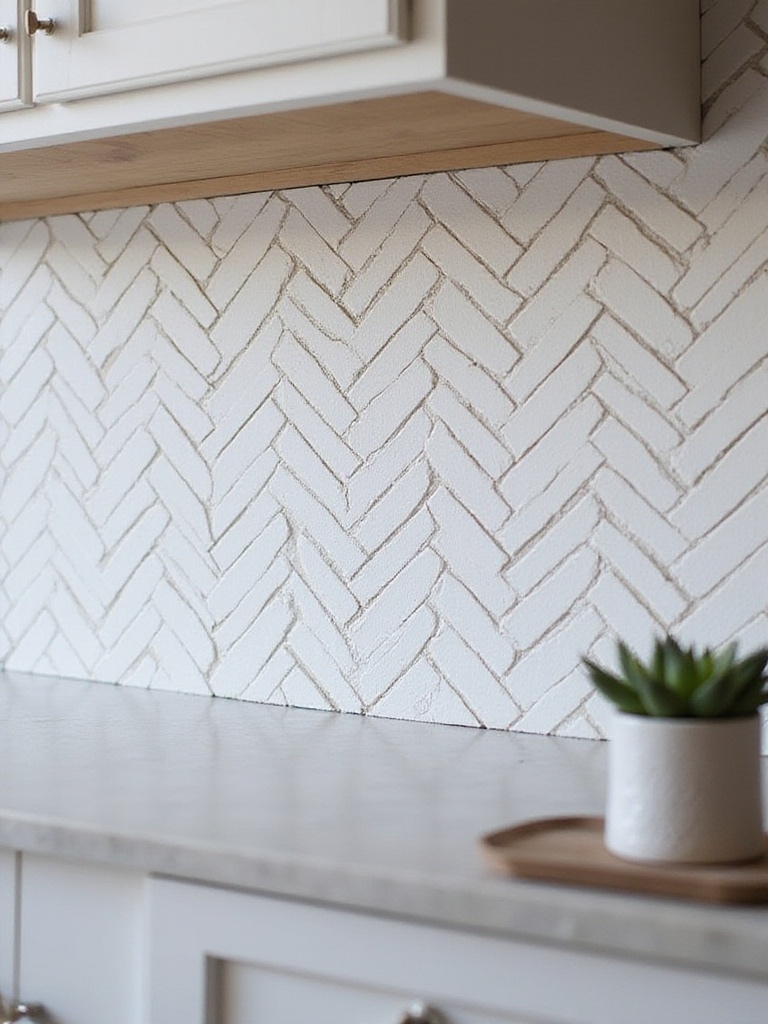
The continuous nature of chevron lines can dramatically influence how your kitchen feels. Horizontal chevron patterns make walls appear wider – perfect for narrow galley kitchens – while vertical applications emphasize height. The pattern also serves as an excellent backdrop for floating shelves or artwork, as the angular lines create visual interest without competing for attention.
Pre-mounted chevron mosaic sheets simplify installation considerably compared to cutting individual tiles. When working with individual tiles, precision becomes paramount – use a level to mark guide lines and ensure each point meets exactly. Consider the scale carefully; larger chevron tiles work well in spacious kitchens, while smaller versions suit compact spaces better.
The sharp geometry of chevron provides an excellent contrast to softer, circular forms like penny rounds.
Penny round tiles offer remarkable versatility, capable of evoking completely different aesthetics depending on color and grout choices. These small circular mosaics, typically measuring 3/4 to 1 inch in diameter, create rich texture that can transport your kitchen to a classic 1950s diner or establish a sophisticated contemporary backdrop. The key lies in understanding how grout color transforms their personality.
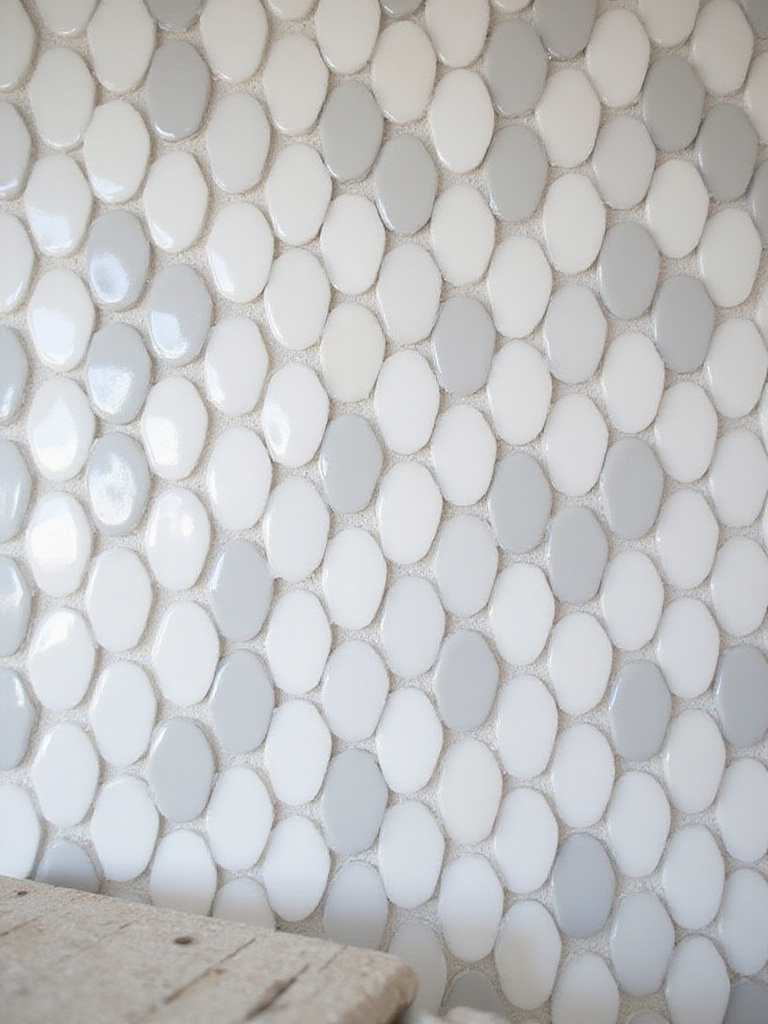
For vintage charm, pair glossy white penny rounds with black grout – the high contrast immediately evokes classic American diners and soda fountains. Conversely, matte gray or charcoal penny rounds with matching grout create subtle, sophisticated texture perfect for modern minimalist kitchens. The small scale also makes penny rounds forgiving on slightly uneven walls, as the flexible mesh backing can accommodate minor irregularities.
Installation success depends heavily on grouting technique due to the high grout-to-tile ratio. Use non-sanded grout for the narrow joints, applying with firm pressure to ensure complete fill. Work in small sections and clean excess grout immediately with a damp sponge, rinsing frequently to prevent haze buildup.
The circular geometry of penny rounds creates organic flow that beautifully complements more complex patterned approaches.
Patterned tiles transform kitchens into personalized spaces that reflect cultural heritage, artistic preferences, or simply a love of bold design. From traditional Moroccan zellige to contemporary geometric prints, these tiles serve as functional art that creates immediate focal points. Used strategically on backsplashes or accent walls, patterned tiles inject personality that makes your kitchen uniquely yours.
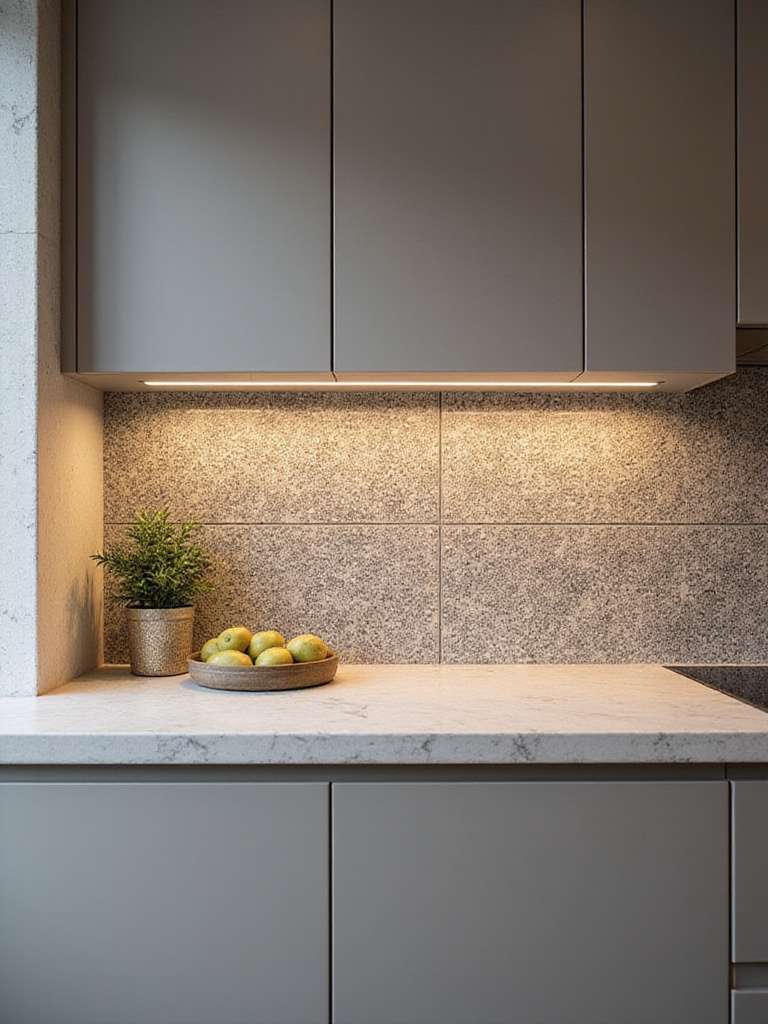
The key to success with patterned tiles lies in restraint and balance. A vibrant patterned backsplash behind the range creates a stunning focal point when paired with neutral cabinets and countertops. Alternatively, small doses of pattern – perhaps a decorative strip or accent panel – can add interest without overwhelming the space. Consider how the pattern scale relates to your room size; intricate small patterns can make compact kitchens feel busy, while larger, simpler patterns work better in smaller spaces.
Sample testing becomes crucial with patterned tiles, as lighting dramatically affects how colors and patterns appear. Order samples and observe them throughout the day in your kitchen’s specific lighting conditions. Consider the long-term maintenance implications, especially for heavily patterned tiles in high-splash areas where grout cleaning becomes more challenging.
The artistic nature of patterned tiles connects beautifully with the detailed craftsmanship found in mosaic work.
Mosaic tiles represent the intersection of art and function, transforming ordinary backsplashes into gallery-worthy focal points. Composed of small pieces of glass, stone, metal, or ceramic, mosaics offer unparalleled opportunities for color blending, texture mixing, and pattern creation. Whether you choose subtle monochromatic schemes or vibrant artistic designs, mosaics elevate your kitchen’s sophistication level instantly.
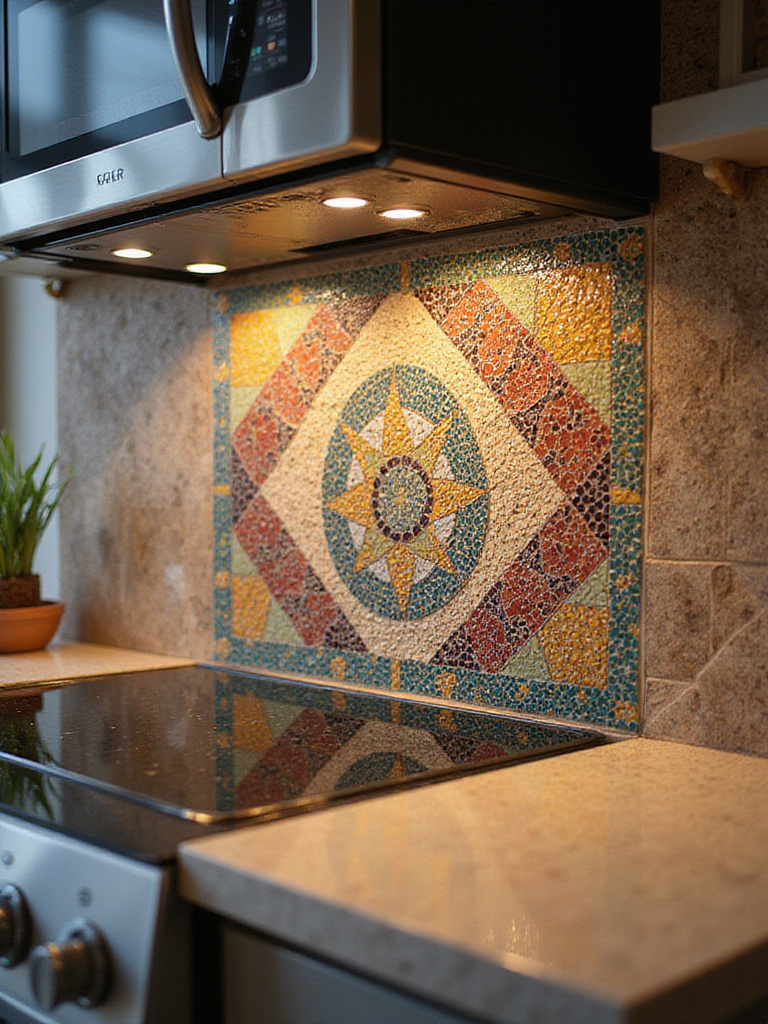
The beauty of mosaics lies in their ability to incorporate multiple materials and colors within a single installation. Imagine combining iridescent glass with natural stone for depth, or mixing metallic accents with ceramic for contemporary flair. This material diversity allows mosaics to bridge different design elements in your kitchen, tying together cabinet finishes, countertop colors, and hardware choices into a cohesive whole.
Professional installation often proves worthwhile for complex mosaics, as proper layout and cutting require specialized skills. If tackling the project yourself, invest in high-quality tools including a wet saw with various blades for different materials. Plan your layout carefully, starting from the most visible center point and working outward to ensure symmetrical placement.
Under-cabinet lighting becomes essential for showcasing mosaic artistry, as it highlights the interplay of textures and reflective surfaces that make these installations truly shine.
Natural stone tiles connect your kitchen to the earth’s inherent beauty, offering textures and color variations that synthetic materials cannot replicate. Marble brings classic elegance with its distinctive veining, while slate provides rustic charm with its naturally textured surface. Travertine offers warm, neutral tones with subtle pitting that adds character. Each stone tells its own geological story, ensuring your kitchen remains unique.
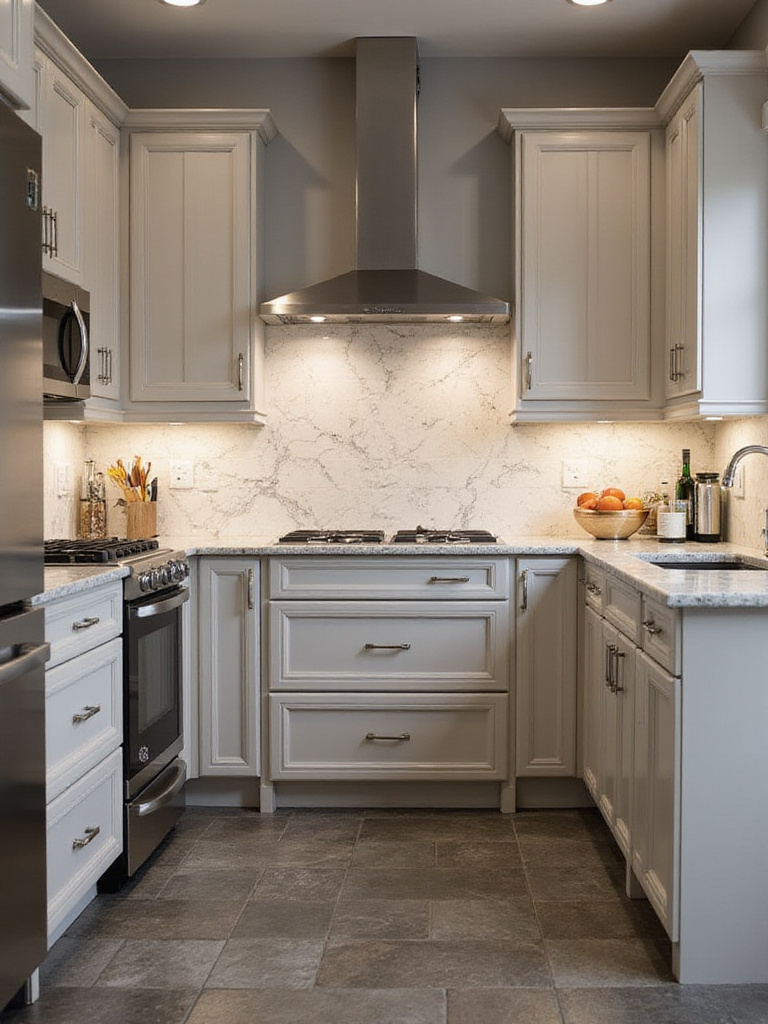
The investment in natural stone extends beyond aesthetics to long-term value. Properly maintained stone surfaces can last decades, developing a beautiful patina that enhances their character over time. This durability, combined with the luxury perception of natural materials, often contributes to higher home values. Stone also offers excellent heat resistance, making it particularly suitable for backsplashes behind ranges.
Sealing becomes crucial for stone longevity in kitchen environments. Apply a high-quality penetrating sealer before and after grouting, then reapply according to manufacturer recommendations – typically annually for high-use areas. Test sealer effectiveness by placing water drops on the surface; proper sealing causes water to bead rather than absorb.
The natural variations in stone create perfect backdrops for exploring how reflective surfaces can enhance your kitchen’s brightness.
Glass tiles transform kitchens through their remarkable ability to capture and redistribute light throughout the space. Their reflective surfaces act like mirrors, bouncing natural daylight and artificial illumination to create brighter, more open-feeling kitchens. This makes glass tiles particularly valuable in compact spaces or kitchens with limited natural light, where every bit of brightness counts.
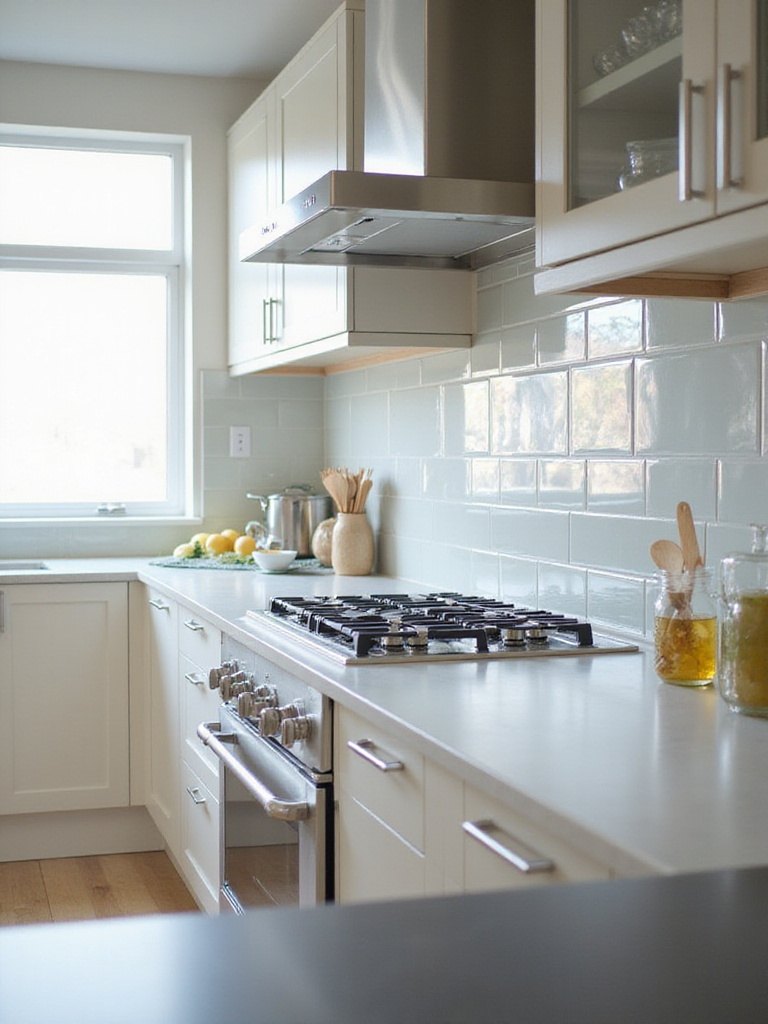
The variety within glass tiles offers options for every aesthetic preference. Polished glass provides maximum reflection for dramatic light play, while frosted versions offer softer illumination that hides minor wall imperfections. Iridescent glass adds subtle color shifts throughout the day, creating dynamic surfaces that change with lighting conditions. The smooth, non-porous surface also makes glass tiles exceptionally easy to clean – crucial for busy kitchen environments.
Installation requires specific techniques to maximize glass tile benefits. Use only white adhesives to prevent color show-through, and ensure substrate surfaces are perfectly smooth since imperfections become visible through translucent materials. Cut glass tiles with specialized blades to prevent chipping, and use non-sanded grout for the best finish.
The luminous quality of glass tiles provides an excellent foundation for incorporating industrial elements that add contemporary edge.
Metal tiles bring urban sophistication and industrial character to kitchens, offering unique textural contrast to traditional ceramic and stone materials. Stainless steel provides clean, contemporary lines that coordinate beautifully with appliances, while copper adds warmth and develops rich patina over time. Aluminum and tin options offer pattern possibilities and lighter weight for easier installation.
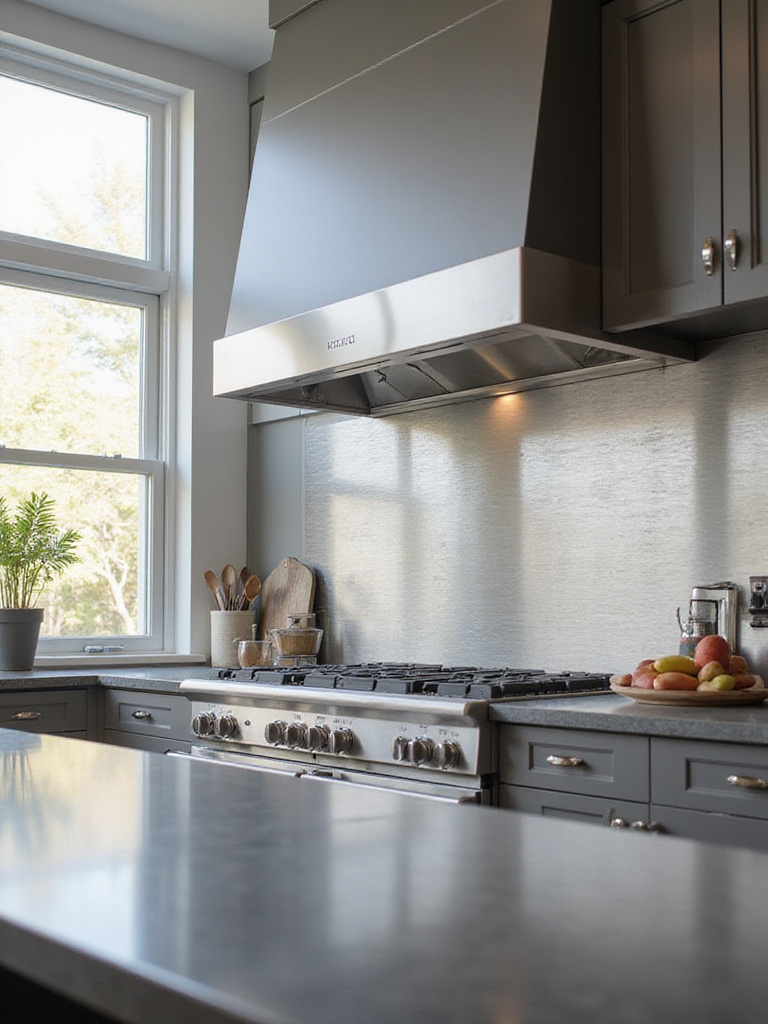
The durability of metal tiles makes them particularly suitable for high-heat areas behind ranges and cooktops. Their heat resistance and easy cleaning properties address practical kitchen needs while adding distinctive style. Metal tiles also reflect light differently than glass, creating softer, warmer reflections that add depth without glare.
Cutting and installation techniques vary by metal type. Stainless steel requires specialized blades and careful handling to prevent scratching, while softer metals like tin can be cut with heavy-duty scissors or snips. Use appropriate adhesives – often construction adhesive or epoxy – and consider expansion joints for large installations to accommodate thermal movement.
The contemporary edge of metal tiles demonstrates how modern materials can enhance traditional kitchen functions, much like ceramic tiles balance style with practicality.
Ceramic tiles prove that beautiful design doesn’t require premium budgets. Modern manufacturing techniques create ceramic options that convincingly mimic expensive materials like marble, wood, and natural stone at a fraction of the cost. This accessibility allows families to achieve high-end aesthetics while maintaining financial flexibility for other kitchen improvements.
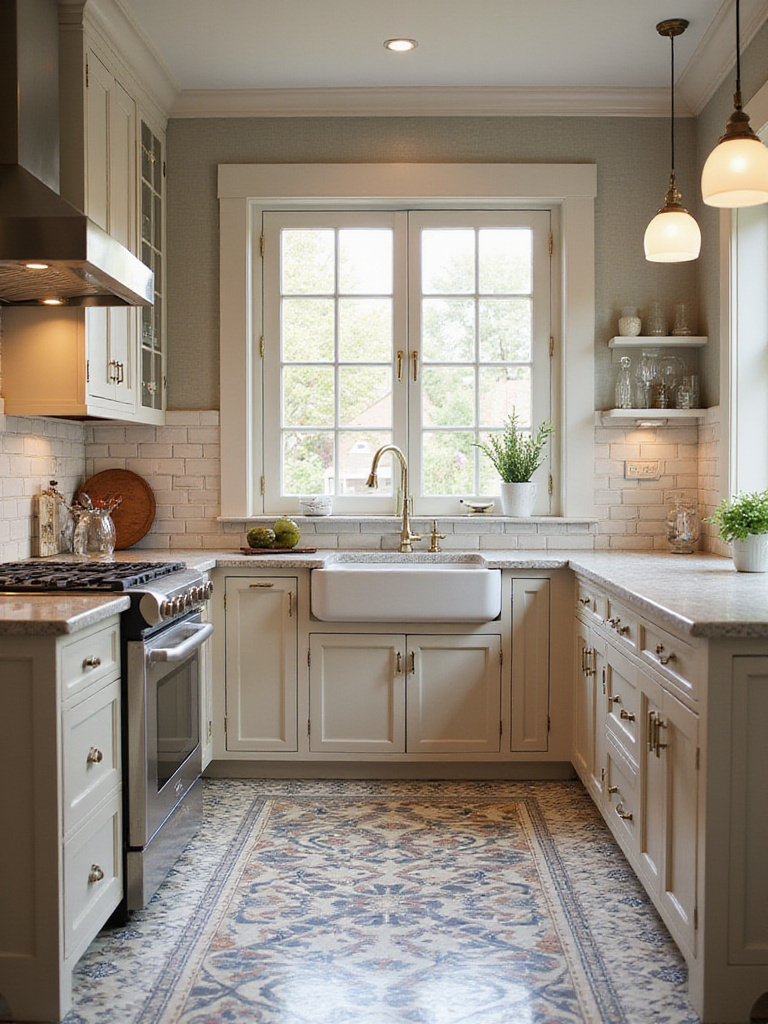
The practical advantages of ceramic extend beyond cost savings. These tiles offer excellent durability ratings suitable for kitchen floors and walls, resist stains and moisture, and require minimal maintenance. The vast selection includes every conceivable color, pattern, and size, ensuring perfect matches for any design vision. From classic subway shapes to contemporary large formats, ceramic tiles adapt to every style preference.
Quality varies significantly among ceramic tiles, so research PEI ratings for durability and consider porcelain options for high-traffic areas. Order samples to evaluate color accuracy and surface texture, as these characteristics can vary between production runs. Factor in grout color early in the selection process, as it dramatically affects the final appearance.
The versatility of ceramic tiles provides an excellent foundation for exploring how large format options can create seamless, modern aesthetics.
Large format tiles, typically 12×24 inches or larger, revolutionize kitchen floors by dramatically reducing grout line visibility. This creates cleaner, more seamless surfaces that align perfectly with contemporary design preferences for uncluttered spaces. The reduced grout coverage also means less maintenance, as fewer porous lines require cleaning and sealing.
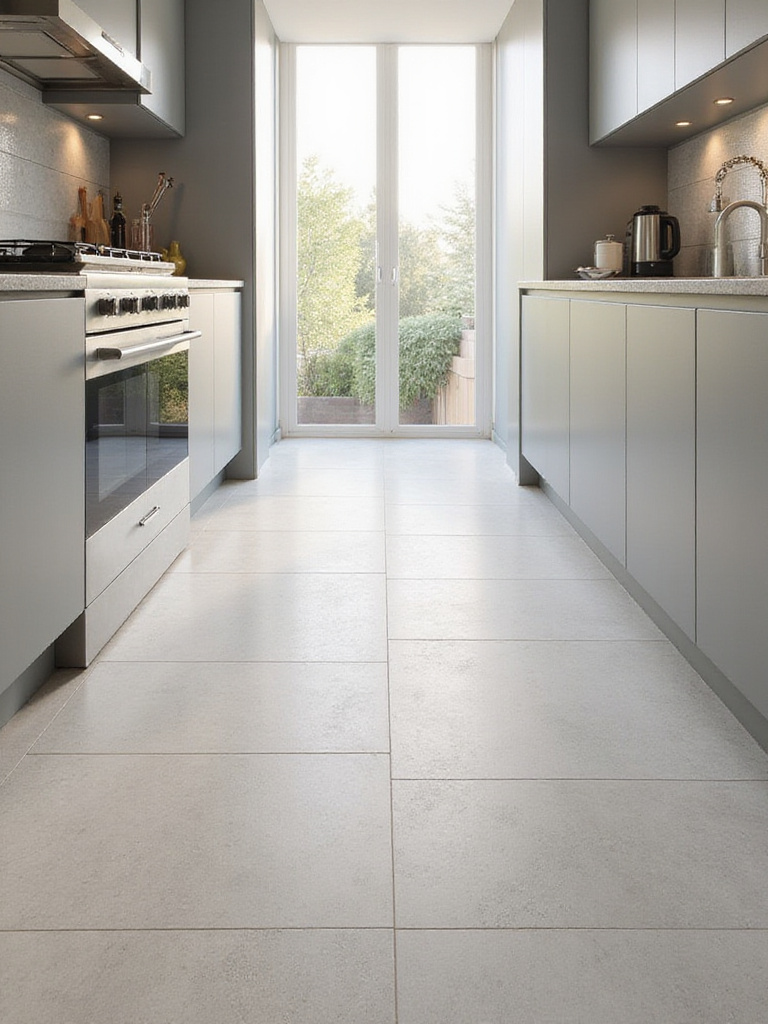
The visual impact of large format tiles extends beyond cleanliness to spatial perception. Fewer grout lines create uninterrupted surfaces that make floors appear larger and more expansive. This effect proves particularly valuable in smaller kitchens where every visual trick helps create openness. The modern aesthetic also provides neutral backdrops that allow other design elements – cabinetry, islands, lighting – to command attention.
Installation precision becomes critical with large format tiles, as imperfections become more noticeable across larger surfaces. Ensure subfloors meet strict flatness requirements, use appropriate large-tile adhesives, and invest in leveling systems to prevent lippage between tiles. Professional installation often proves worthwhile for optimal results.
The sleek minimalism of large format floors creates perfect foundations for introducing personality through bold color choices.
Bold colored tiles transform kitchens from neutral backgrounds into vibrant expressions of personal style. Whether you choose energizing yellows, sophisticated emerald greens, or dramatic deep blues, colored tiles create instant focal points that reflect your family’s personality. Used strategically on backsplashes or accent walls, bold colors add life and character without overwhelming the space.
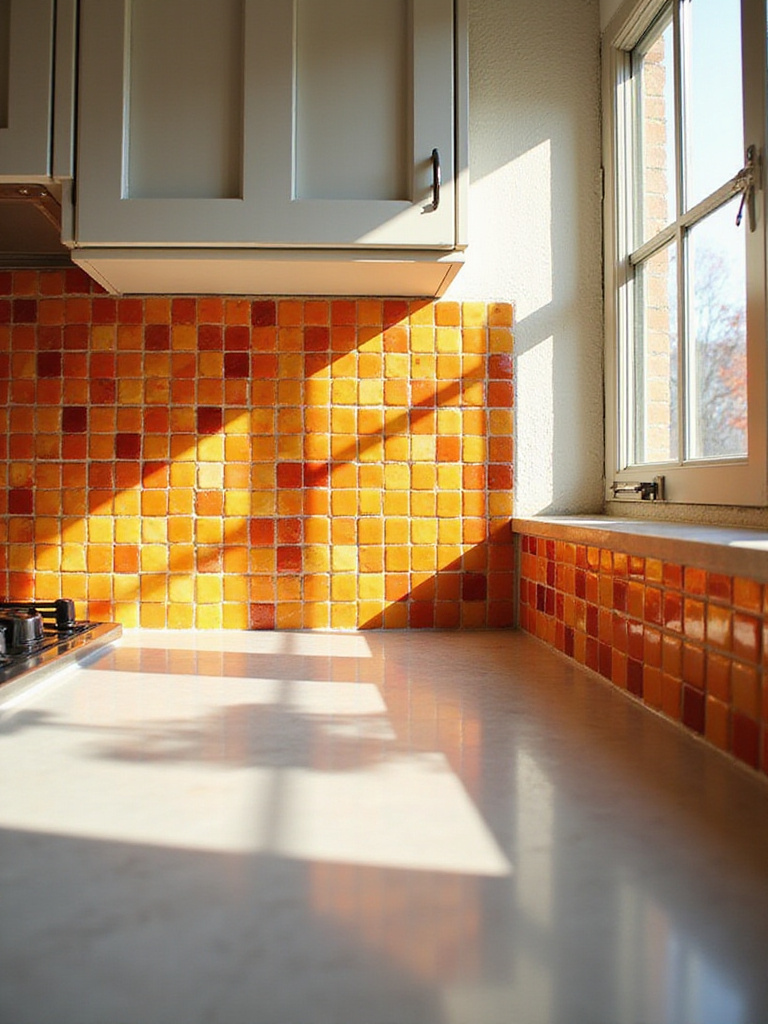
The psychology of color plays an important role in Kitchen design, as this space influences daily moods and family interactions. Warm colors like terracotta or golden yellow create welcoming, energetic environments perfect for morning routines and family gatherings. Cool colors like sage green or ocean blue provide calming backdrops that balance busy kitchen activities. The key lies in choosing colors that enhance your family’s lifestyle and complement existing finishes.
Color testing becomes essential, as kitchen lighting dramatically affects how hues appear throughout the day. Order large samples and observe them under both natural and artificial light at different times. Consider the longevity of bold color choices – will you love that vibrant orange in five years? Balance bold tiles with neutral elements to ensure design flexibility as tastes evolve.
The energy of bold colors provides an interesting contrast to the subtle sophistication of matte finishes.
Matte finish tiles offer sophisticated alternatives to high-gloss surfaces, creating contemporary aesthetics that feel both refined and approachable. The low-sheen surface absorbs rather than reflects light, producing calm, even illumination that reduces visual noise in busy kitchens. This quality makes matte tiles particularly effective for families seeking serene environments that balance kitchen activity with peaceful ambiance.
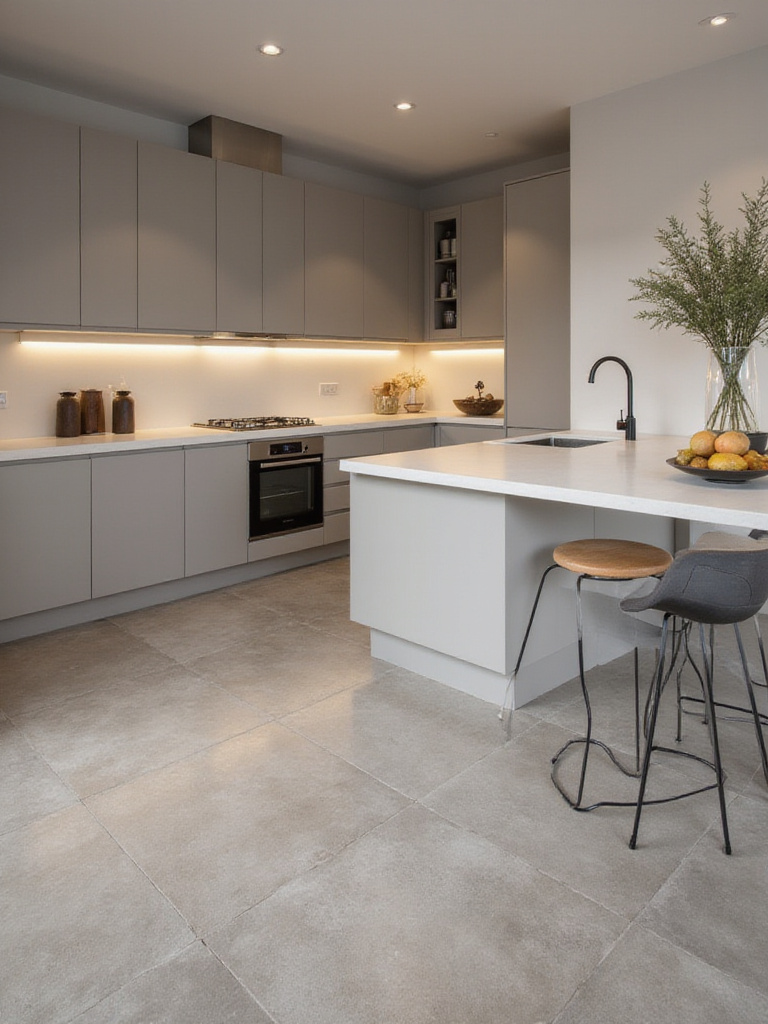
Practical benefits extend beyond aesthetics to daily maintenance. Matte surfaces hide water spots, fingerprints, and minor scratches far better than glossy alternatives, maintaining clean appearances with minimal effort. The slightly textured surface also provides better slip resistance for floor applications – an important safety consideration in kitchens where spills occur regularly.
Lighting design becomes crucial with matte finishes, as these surfaces don’t reflect light to brighten spaces naturally. Plan for adequate ambient, task, and accent lighting to prevent rooms from feeling flat or dim. Consider mixing matte tiles with other finishes – perhaps glossy countertops or metallic hardware – to add depth and visual interest.
The understated elegance of matte finishes creates perfect backdrops for exploring dimensional textures that add sculptural interest.
Three-dimensional textured tiles transform flat walls into sculptural surfaces that engage both sight and touch. These tiles feature raised patterns, geometric shapes, or wave-like formations that extend beyond the tile plane, creating dynamic shadows and highlights that change throughout the day. Used strategically as backsplash focal points or accent walls, 3D tiles add architectural interest that elevates kitchen design sophistication.
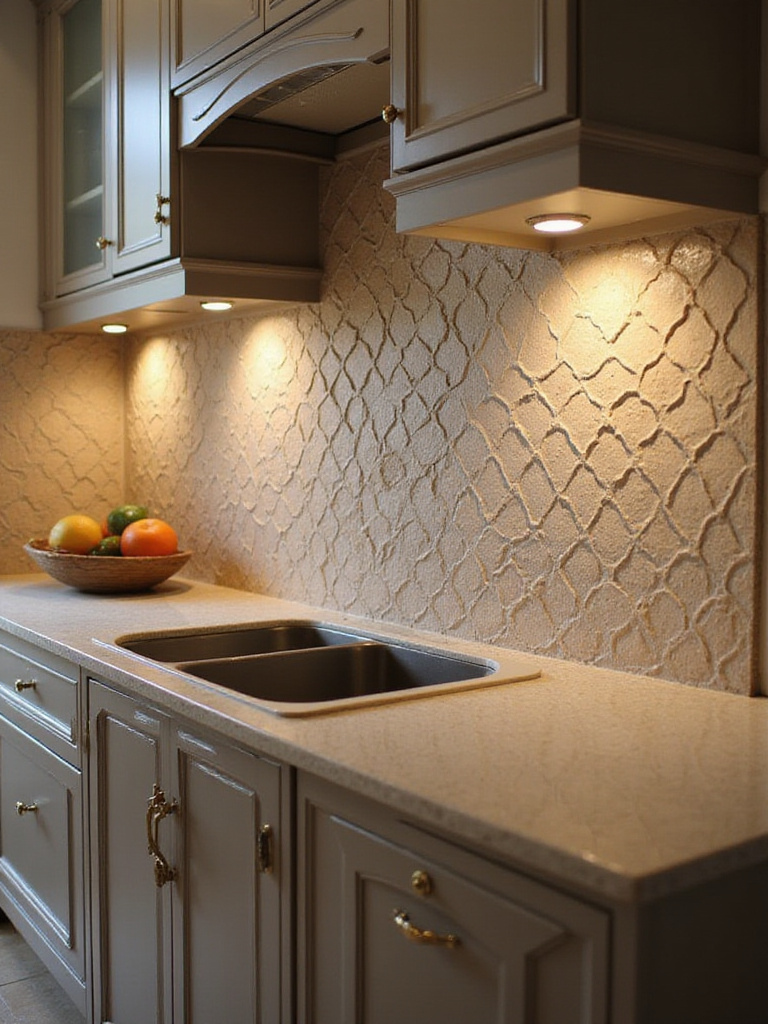
The interplay between texture and lighting creates ever-changing visual experiences. Morning light grazing across wave patterns produces different shadows than evening illumination, making your kitchen feel dynamic and alive. This quality proves particularly valuable for families who spend significant time in their kitchens, as the changing patterns provide visual interest that prevents spaces from feeling static or boring.
Lighting placement becomes critical for maximizing 3D tile impact. Under-cabinet LED strips positioned to graze across textured surfaces enhance shadow play, while strategically placed accent lights can create dramatic focal points. Consider how the texture scale relates to your kitchen size – large, bold textures work well in spacious areas, while subtle textures suit compact spaces better.
The dimensional quality of textured tiles demonstrates how surface variation can create impact, much like the contrast between white tiles and dark grout lines.
The combination of white tiles with dark grout creates striking graphic effects that transform simple installations into bold design statements. This high-contrast approach works with any white tile shape – subway, hexagon, square, or geometric patterns – making the tile outline the star of the show. The technique instantly modernizes classic materials while providing practical benefits for busy kitchen environments.
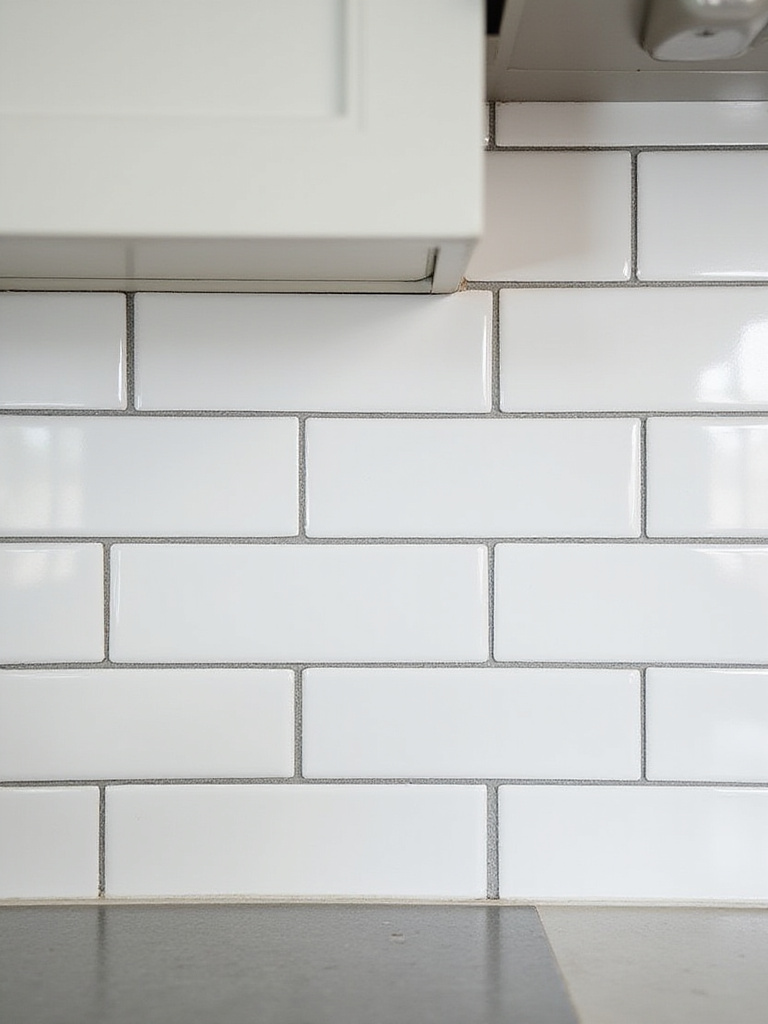
Dark grout lines serve as visual frames that define each tile’s shape and create strong geometric patterns. This graphic quality adds architectural interest and can influence spatial perception – horizontal patterns make walls appear wider, while vertical arrangements emphasize height. The bold contrast also disguises everyday kitchen stains and splashes far better than light grout, maintaining clean appearances with less frequent deep cleaning.
Grout color selection requires careful consideration of your overall design goals. Charcoal gray provides sophisticated contrast without being stark, while true black creates maximum drama. Consider the tile’s edge quality – rectified tiles with precise edges work better with narrow dark grout lines, while standard tiles may require wider joints that affect the final appearance.
The graphic impact of contrasting grout demonstrates how simple techniques can create drama, leading naturally to exploring vertical applications that maximize impact.
Taking backsplash tile from countertop to ceiling creates powerful architectural statements that transform kitchens from ordinary to extraordinary. This approach maximizes your tile investment’s visual impact while providing practical benefits like complete wall protection and easier maintenance. The continuous surface also eliminates the need for paint or other finishes above traditional backsplash heights.
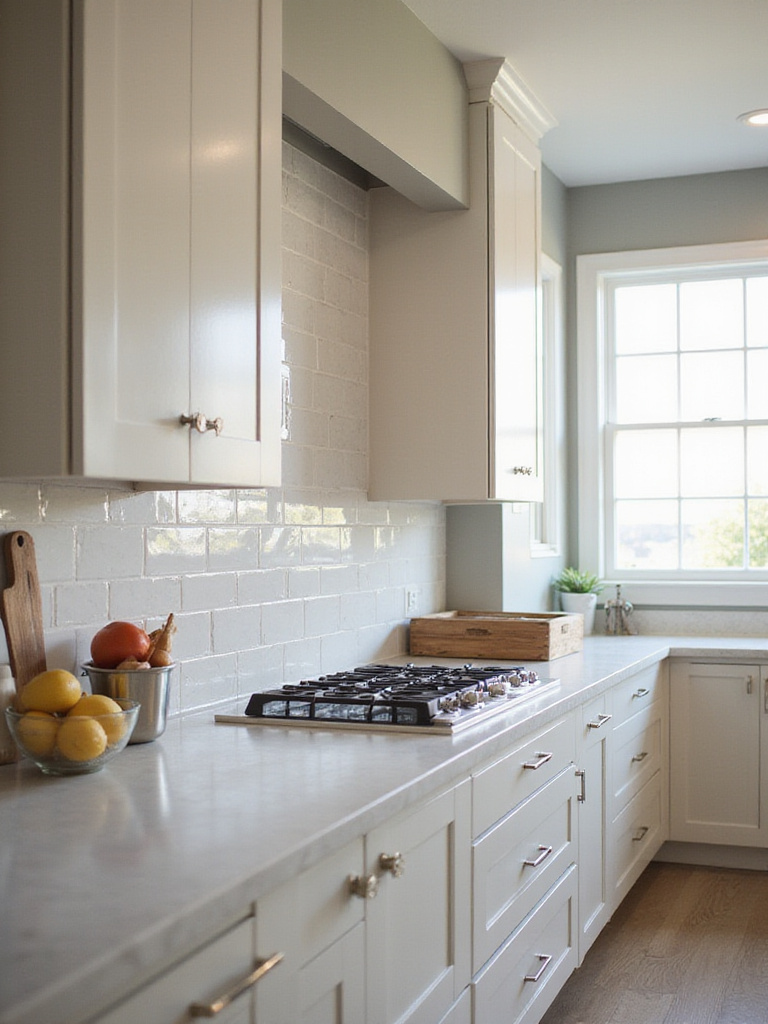
Full-height tile installations dramatically alter spatial perception, making ceilings appear higher and rooms feel more expansive. This technique proves particularly effective in kitchens with standard 8-foot ceilings, where the uninterrupted vertical lines create illusions of greater height. The approach also provides cohesive backdrops for open shelving, artwork, or architectural details.
Layout planning becomes crucial for ceiling-height installations, as awkward cuts at the top become highly visible. Start your layout from the most prominent area and work outward, ensuring any partial tiles fall in less noticeable locations. Consider using trim pieces or decorative borders at the ceiling line for finished appearances.
The bold statement of floor-to-ceiling tile sets the stage for exploring how smaller decorative elements can add custom details.
Decorative borders and accent strips add custom details that elevate standard tile installations into sophisticated design features. These elements use contrasting materials, colors, or patterns to frame areas, highlight features, or create visual breaks in large expanses of tile. The technique allows strategic use of premium materials – like handcrafted mosaics or metallic accents – in smaller quantities for maximum impact.
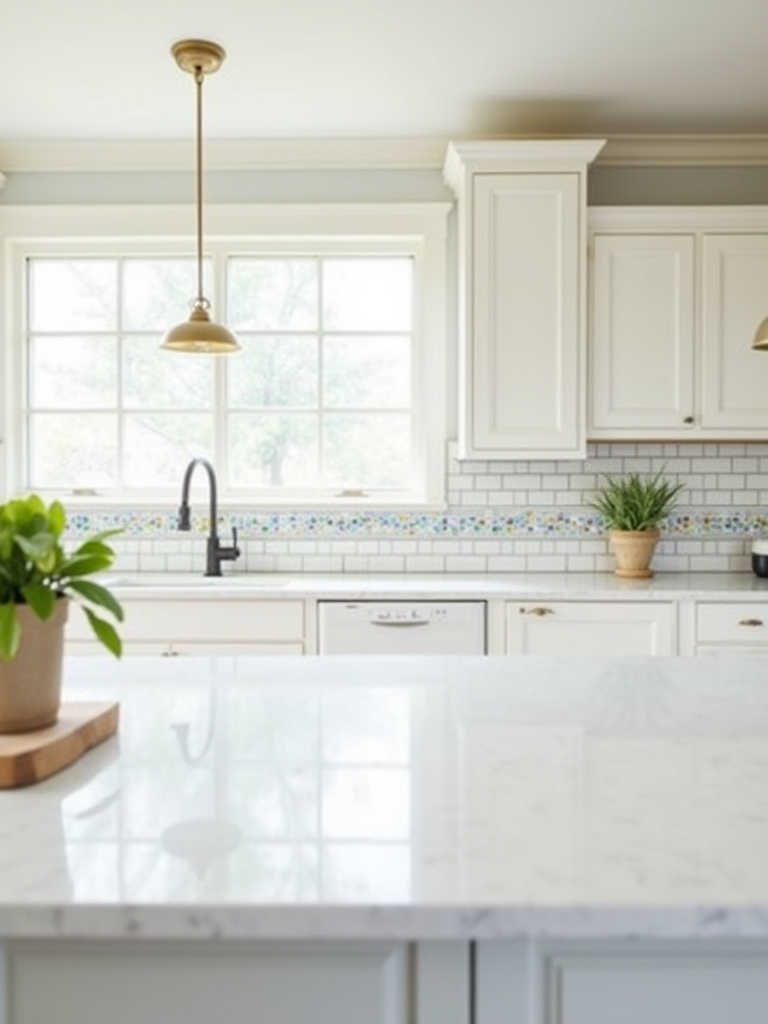
Border treatments serve multiple design functions beyond decoration. They can define cooking zones behind ranges, frame sink areas, or create visual separation between different kitchen functions. Horizontal borders can make walls appear wider, while vertical accents draw attention upward. The custom appearance adds perceived value and demonstrates attention to design detail that distinguishes your kitchen from standard installations.
Proportion becomes critical when planning decorative borders – too wide in small kitchens feels overwhelming, while too narrow in large spaces gets lost. Consider the border material’s relationship to surrounding tiles in terms of thickness, texture, and maintenance requirements. Plan installation sequence carefully to ensure proper alignment and clean transitions.
The custom quality of decorative borders connects beautifully with the idea of combining different materials for rich, layered effects.
Mixing tile materials within single installations creates sophisticated, layered aesthetics that reflect personal style and design confidence. Combining elements like smooth glass with textured stone, or matte ceramic with metallic accents, produces rich visual tapestries that serve as kitchen focal points. This approach moves beyond uniform surfaces to create truly bespoke environments.
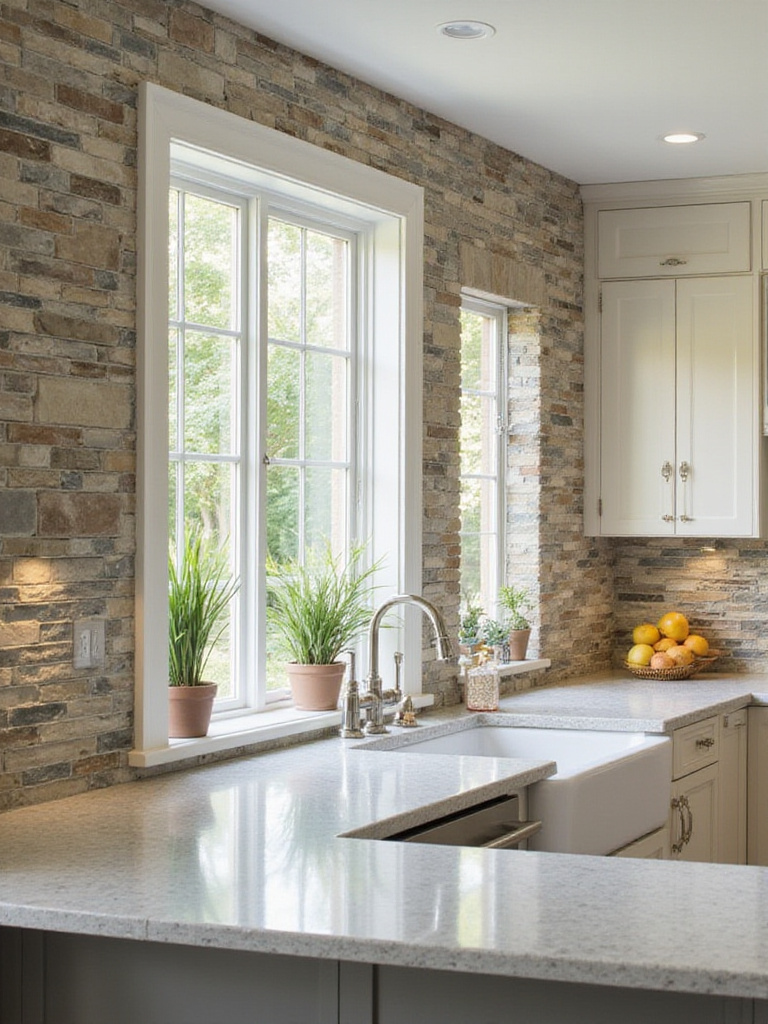
The key to successful material mixing lies in finding common elements that tie different materials together – perhaps similar color tones, complementary textures, or shared geometric shapes. This creates cohesion while celebrating diversity. Material combinations also allow you to balance practical considerations; use durable porcelain for most areas while incorporating delicate glass mosaics as accent elements in lower-splash zones.
Planning becomes essential when combining materials with different installation requirements, thicknesses, or maintenance needs. Create detailed layouts showing material transitions, and consult with experienced installers about techniques for managing different substrate requirements. Consider long-term maintenance implications, as different materials may require different cleaning products or sealing schedules.
The sophisticated layering of mixed materials demonstrates advanced design thinking, while simpler solutions like peel-and-stick options offer accessible alternatives for quick updates.
Peel-and-stick tiles revolutionize kitchen updates by offering style transformations without permanent commitment or professional installation requirements. These adhesive-backed tiles apply directly over existing smooth surfaces, making them perfect for renters, budget-conscious homeowners, or anyone seeking quick refresh options. Modern versions convincingly mimic ceramic, subway, and mosaic tiles with realistic textures and patterns.
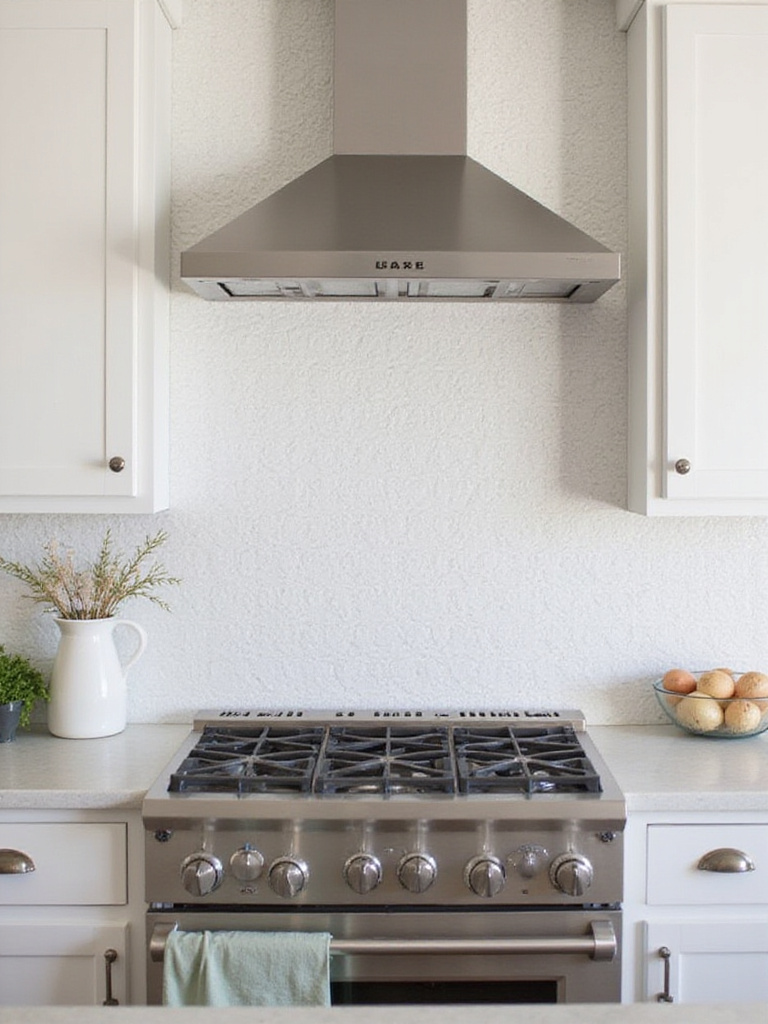
The accessibility of peel-and-stick technology democratizes kitchen design, allowing anyone to achieve professional-looking results with basic tools and minimal time investment. Installation typically takes hours rather than days, and removal rarely damages underlying surfaces when done properly. This flexibility appeals to families who enjoy changing their décor seasonally or those testing design ideas before committing to permanent installations.
Surface preparation determines peel-and-stick success – walls must be clean, smooth, and completely dry for optimal adhesion. Plan your layout carefully using levels and measuring tools, as repositioning becomes difficult once tiles contact the wall. Start from the most visible corner and work systematically for professional-looking results.
These accessible options prove that beautiful kitchen transformations don’t require major renovations or permanent commitments.
These 20 kitchen tile ideas demonstrate tile’s remarkable power to transform the heart of your home through thoughtful material choices, creative patterns, and strategic applications. From the graphic impact of contrasting grout to the sophisticated layering of mixed materials, each approach offers unique opportunities to reflect your family’s personality while addressing practical kitchen needs. The beauty lies in tile’s versatility – whether you’re drawn to bold colors that energize morning routines, natural stones that connect your space to the earth, or innovative 3D textures that create sculptural interest.
The key to successful tile selection lies in understanding how different options serve your specific lifestyle requirements. Families with multiple generations might prioritize easy-maintenance surfaces like large format floors with minimal grout lines, while those embracing cultural heritage might choose patterned tiles that tell personal stories. Budget-conscious households can achieve stunning results with ceramic options or peel-and-stick solutions, while those seeking long-term investments might choose natural stone or custom mosaic installations.
Your kitchen transformation begins with identifying which of these kitchen tile ideas resonates most strongly with your vision and practical needs. Start by gathering samples, testing them in your specific lighting conditions, and considering how they integrate with existing elements. Whether you choose dramatic floor-to-ceiling installations or subtle accent borders, the right tile choices will create a kitchen that serves your family beautifully for years to come.